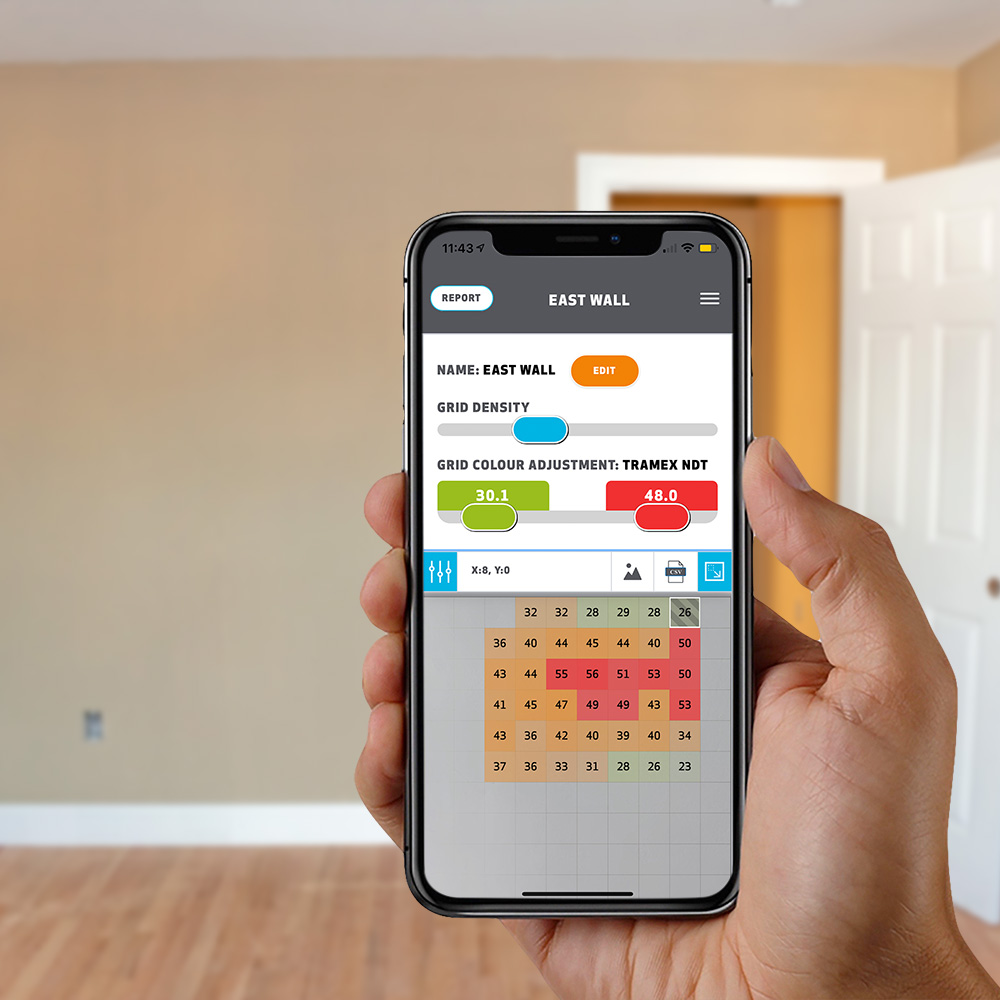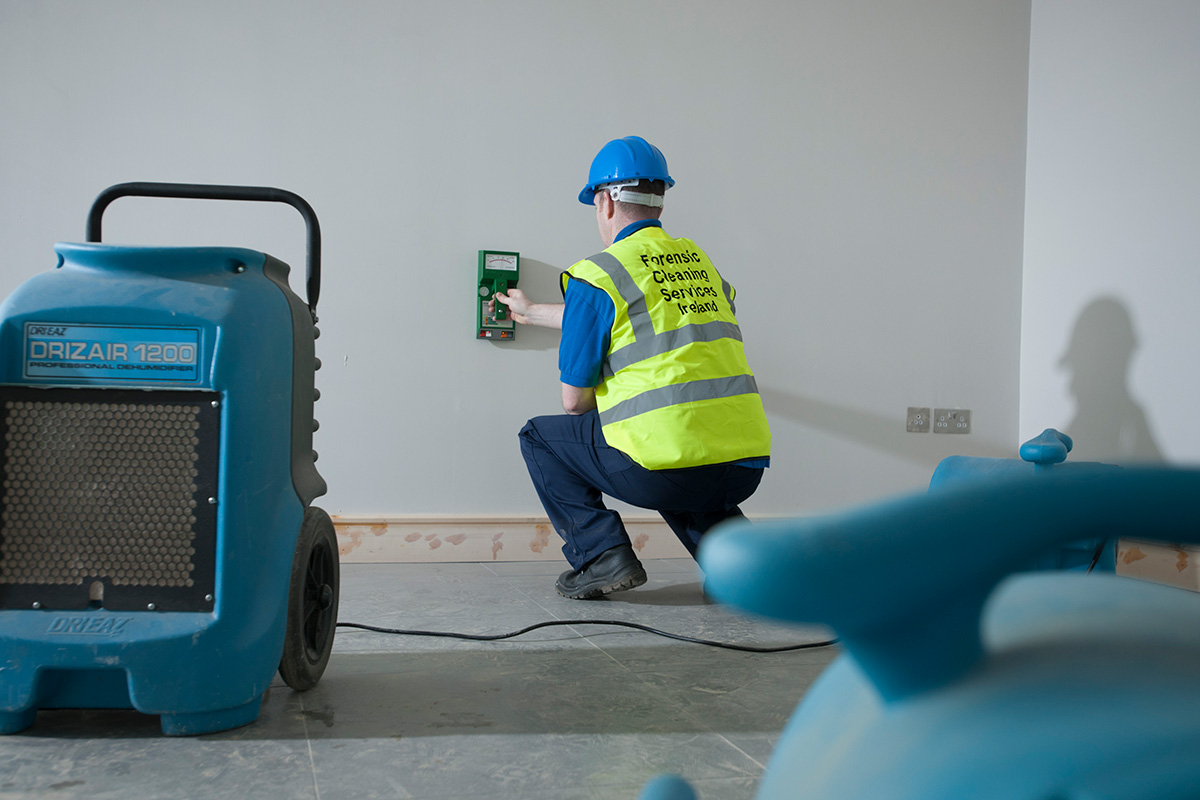
The goal of moisture detection in the water damage restoration industry is to identify and assess abnormally wet locations of buildings, structures and their materials so that the drying process can be measured, documented and carried out effectively and in an economical and efficient manner.
Why do you need a water damage survey?
The building investigation and/or restorative drying professional should establish the source and extent of the moisture damage that has occurred as well as a baseline moisture content objective or ‘drying goal’. Excess moisture and humidity left within a building environment or its structural elements is the cause of damage to structural materials such as rot, mold growth, reduced insulation values, failure of flooring, roofing and wall support. To avoid such issues the building investigation and/or restorative drying professional needs the right diagnostic and drying equipment to carry out their work professionally and efficiently.
How to assess water damage
The moisture and humidity conditions of the building structure and its environment need to be tested at the beginning, during and at the end of the drying process. The best way to measure and document the progression of the drying process is with dependable thermo hygrometers for environmental ambient conditions, moisture meters for the moisture conditions of building materials and mapping technology to document these readings. To carry out the building investigation and restorative process efficiently and effectively it is also important to have knowledge of the building construction components and materials, as well as the internationally recognized standards and reference guides for water damage restoration, such as IICRC S500. Initially, using infrared cameras and moisture meters, it is necessary to establish which building materials are ‘wet’, which are ‘not wet’, and to trace the leak back to its source.
Moisture map the water damage
Determining the cause of loss or point of entry, identifying and mapping the ‘what’s wet’ and ‘what’s not wet’ will allow for focused drying where most needed, and once measurable, ongoing monitoring helps ensure the materials are drying properly. Having brought the elevated moisture conditions back to measurable drying conditions, the monitoring of the drying process begins with the identification of all of the affected materials. By tracking the water from its initial source, diligently following it in every direction it has migrated, the restorative drying professional can establish an accurate and precise picture of the extent of the damage in a moisture map.
What is a moisture map?
Moisture maps are visual representations—typically photographs or drawings—of affected surfaces, overlaid with a grid that indicates the moisture levels of structural materials at each mapped location. Click here to see a video of how to create a moisture map with the Tramex Moisture Encounter ME5 and the Tramex Meters App. An understanding of the types of affected materials, their porosity, the extent of the water absorption, as well as an understanding of moisture movement, will provide the framework for the management of the drying process.
Tramex Meters App with Moisture Mapping Feature
Benefits of moisture mapping in water damage restoration
Moisture mapping is a valuable method for identifying both the location and extent of moisture-affected areas, along with the corresponding moisture content levels, compared to the ‘dry standard’ established from unaffected areas. They allow the user to clearly visualize the water migration and delineate the dry areas from the wet areas, and the varying degrees of moisture quantity within that wet area. The restorative drying professional can clearly record each reading for each segment of the affected area, and record repeated readings for the exact same grid segments, throughout the drying process.
The maps will be included in the moisture map report, along with the thermal imaging documentation, serving as an accessible communication tool between the professional and client, greatly facilitating communications among trades, insurance companies, adjusters, attorneys and other professionals and also serving as invaluable data in cases involving controversy. They are also a means of archiving vital information for reference in future building diagnostic projects. Moisture meters, pin meters , thermo hygrometers, and moisture mapping provide the restorative drying professional with vital information so that the drying efforts can be concentrated on the most affected areas and the drying process efficiently managed.
Moisture movement in building structures
The restorative drying professional must first identify and solve the water intrusion problems in order to prevent additional water intrusion or future damage to the structure and its components. The source of the water intrusion can vary from failures in fixtures or plumbing, to building defects, rising damp, weather events or flooding, leaking roofs, spillage or condensation. Understanding the concepts of moisture movement in the building materials and their surrounding environment is then crucial to increasing the quality of the work. Moisture movement occurs in essentially four ways.
- Liquid flow: Velocity, pressure and especially gravity will play a large part in determining the movement of moisture through affected building materials.
- Capillary action: This is the ability of liquid to migrate upwards, rising through a narrow space or porous materials, against the force of gravity because of inter-molecular attractive forces between the liquid and the surrounding solid materials.
- Air movement: Air movement plays a significant role in the movement of moisture. When the ambient conditions of the air moving across the surface of the material containing moisture are drier than the material itself, the drier air will accommodate evaporation. Air movement will also create a suction effect that will help pull liquid moisture from porous materials.
- Vapor diffusion: Moisture vapor will always move from wet to dry, moving through the materials, subject to the permeability of the material as well as the vapor pressure differential. Most building materials are hygroscopic, meaning that they absorb and retain moisture until they attain vapor equilibrium with the environment. Understanding the movement of moisture through the building materials in question, be they solid or engineered wood, drywall, insulation, masonry, roofing materials, concrete or behind hard surfaces, allows for better management of the drying process.
Water damage assessment to detect water intrusion
Water intrusion through the envelope of a structure, can result in visual deterioration of a surface, structural damage in timbers, metal and other building components. However, the identification of this water intrusion, the damage assessment and the monitoring of a drying process is not obtained with the naked eye alone. Although some damage assessment may be visible in the initial inspection, often the water intrusion will be hidden. Identifying the affected areas and the extent of the water intrusion and tracing the leak back to its primary source may require non-destructive measurement using non-invasive moisture meters, such as the Tramex Moisture Encounter ME5, Moisture Encounter MEX5 or the Roof and Wall Scanner, as well as other invasive types of investigation, such as using pin-type meters and probes. Knowledge of what is ‘wet’ and what is ‘dry’ is vital. To ascertain what is wet and what is dry, we compare the affected area to a ‘Dry Standard’. This is established by obtaining a moisture reading of a known unaffected material. If it is unknown, the equilibrium relative humidity (ERH) can be used.
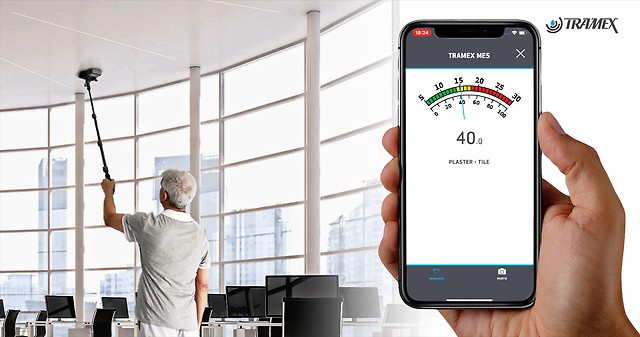
Tramex Moisture Encounter ME5, measuring on ceiling with and extension handle and Tramex Meters App.
Using the right moisture detection tools and moisture mapping tools
The single most critical factor in defining the amount of potential damage is by the use of moisture detection and evaluation tools. Moisture meters will quantify the moisture, on either a relative or absolute scale, and this numerical value can then be documented through the utilization of moisture mapping techniques.
More and more cleaning and restoration professionals are using a combination of infrared cameras, thermo hygrometers, moisture meters and modern moisture mapping technology. The professional will have a detailed and precise visual documentation of the extent of damage and the drying process, saving time and money in the initial damage assessment stage and throughout the drying process. The combination of IR, thermo hygrometers and moisture meters means little or no destructive testing is required, which represents substantial savings for the building or home owner. Infrared thermal imaging cameras are a time-saving tool that depict temperature differentials and provide a graphic documentation of areas of suspected moisture intrusion. However, temperature differentials may not always be moisture related and may depict an insulation void, an air leak or multiple layers of building material. The verification of these suspected areas can be achieved with the use of moisture meters, which can detect and evaluate moisture conditions both on the surface and deep within and behind building materials. This is done either by non-destructively measuring the electrical impedance, by measuring the resistance between pin-type electrodes, or by measuring the relative humidity of an air space within the building material. Thermo hygrometers also allow for the important ambient condition readings of temperature, relative humidity, dew point and grains per pound to be recorded.
Non-invasive, non-destructive or pinless moisture meters
Two types of moisture meter are available to the building diagnostics professional: non-penetrating and penetrating, also known as non-invasive or invasive.
Invasive testing is not always possible, permissible or necessary. Non-invasive meters are very effective for initial troubleshooting and inspection, giving a quick indication of the location of elevated moisture and its source. Operated by selecting the most appropriate scale and pressing the handheld instrument onto the material being tested, they can instantly detect moisture and location of moisture related problems. They leave no trace of their use and cause no damage to the materials being tested. The contact electrodes set up an electrical field on the surface of the wood or structural material. The field of non-destructive penetration into the material being tested is to a depth of up to 1.25 inches for pocket sized meters, and 4 inches for larger handheld impedance meters, as used for scanning EIFS and similar materials. When the materials are dry, the signals are insulated from one another, and there will be low readings.
The meter will ‘read’ the level of moisture when the material is wet, as the moisture is conductive and completes the circuit. Meters that have exposed softer electrodes that are in direct contact with the material are more precise with much better depth of penetration than those that have electrodes enclosed behind the meter casing. The exposed conductive rubber pad versions are less prone to signal interference or being affected by static buildup. They give quantitative percentage moisture content by weight values in materials such as concrete and wood and comparative values in most other building materials such as drywall, roofing, plaster and brick. This allows the restorer to evaluate the initial moisture content of the damaged area, helping the technician determine where to concentrate their drying efforts, as well as monitoring the progression of the drying process. Some moisture meters also offer the ability to connect to a range of wood probes as well as relative humidity probes, giving the user the versatility of using both methods.
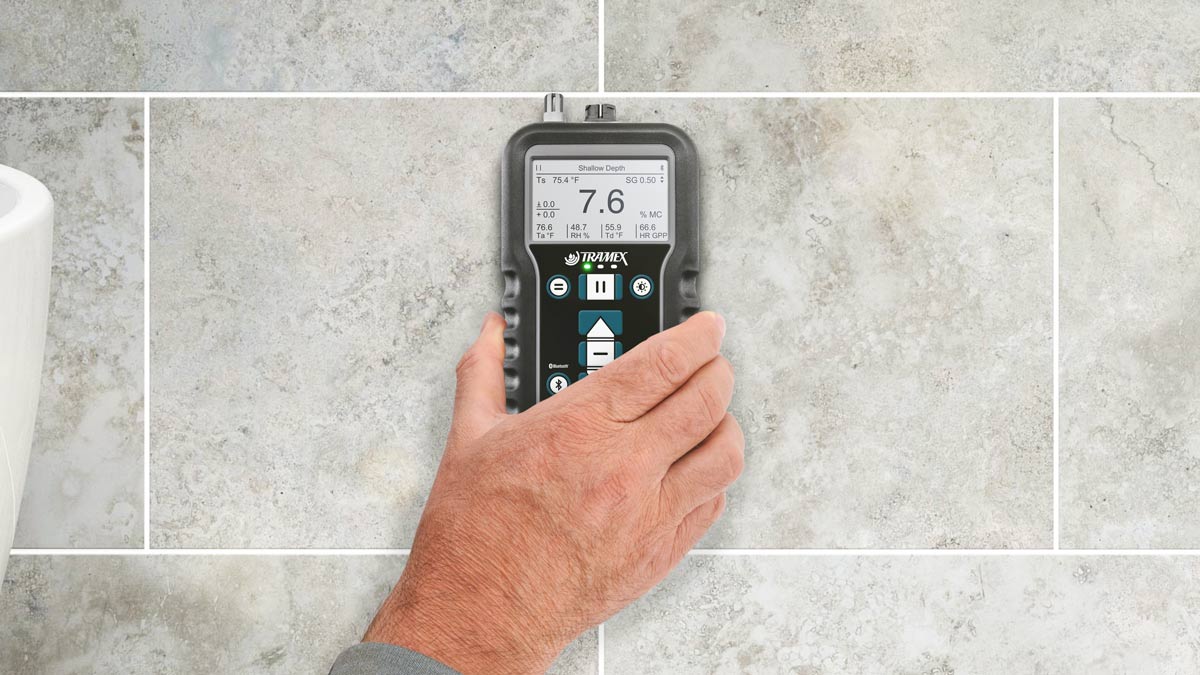
Tramex Moisture Encounter MEX5, on Tile.
Invasive, pin moisture meters and probes
Invasive moisture detection refers to the use of pins or probes for testing the moisture conditions of building materials. Pin-type resistance meters are mainly utilized in the wood industry, giving percentage moisture content by weight readings. Most models are available with a scale calibrated for one species of wood with conversion or adjustment charts to cover other species of wood. Pin-type electrodes, such as the Tramex Heavy Duty Electrode, can also give comparative readings in other building materials. The electrodes penetrate the surface, are pushed or ‘hammered’ into the material and an electrical current is sent between the pins. Moisture conditions are measured by how easily an electrical current passes from one pin to the other, varying with the amount of moisture present. Using moisture meters that can incorporate accurate and reusable relative humidity probes, such as the Tramex Hygro-i2 RH probe, the restorative drying professional can acquire precise relative humidity, temperature, dew point and grains per pound readings. The relative humidity probes will take these readings from the building’s environment, sealed air spaces created in or above concrete and in air spaces behind walls and ceilings. The Narrow RH Sensor can be used to take RH readings in small or narrow crevices.
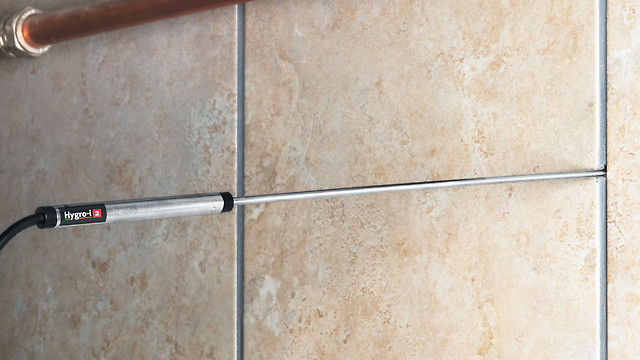
Tramex Narrow Relative Humidity Probe
The combined use of these instruments and techniques provides a fast and professional way to depict, document and assess the moisture conditions throughout the drying process, from the first to the final inspection, when the drying goal is achieved.
By Ronan Carrigy,
Marketing Associate, Tramex Meters Limited.
With acknowledgements to Mike Eggman, Director, Infrared Building Solutions Limited.
